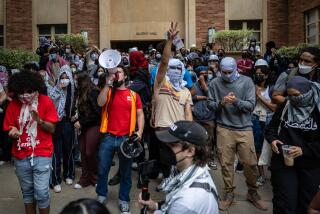Protests Over French Labor Law Expose Social Chasm
- Share via
PARIS — The promise of action lured them from distant housing projects to the capital’s historic Place de la Republique, where tens of thousands of marchers had gathered for a day of protest.
Lionel Morellon and Johan Ardenne dressed for the occasion in the baggy street uniform of casseurs, or urban vandals. Morellon’s long-sleeved red shirt bore a map of his native Guadeloupe, a French Caribbean island. The bushy-haired 20-year-old concealed his face with a scarf. Ardenne, 19, tall and rangy, his hair arranged in short African braids, wore a dark hooded sweatshirt with the same map. As the subway train neared its destination, he turned up his hood.
The crowds were assembling for a demonstration March 28 against a new labor law. But Morellon, Ardenne and two teenage friends had no interest in that. For them, the day was about hunting prey among protesters and passersby. And they ended up in jail.
Strikes and street skirmishes involving student protesters are traditions in France. But robberies, beatings and lootings by hundreds of casseurs from the projects who infiltrated protests in Paris and other cities have added a new and volatile element to a political crisis over labor reform.
The new law, proposed in response to nationwide riots in immigrant areas last fall, was intended to help young men like Morellon and Ardenne: dropouts with criminal records, no jobs and few prospects. As far as most youths from their bleak neighborhoods are concerned, however, the politicians and the protesters are symbiotic representatives of a privileged French society that has little to do with them. And the demonstrations have become tempting targets for gangs.
According to confessions and court testimony, the four young men surrounded a man on a subway platform and demanded his MP3 player and cellphone. Morellon punched the man repeatedly in the face before he and the others stomped him. Caught in the act by police on foot patrol, one assailant tossed a dagger onto the tracks.
The police confiscated three stolen MP3s from Ardenne. Morellon first claimed that he had come from Corbeil-Essonnes, south of Paris, for the demonstration against the labor law, known as the CPE. But when police asked him what the CPE was, he said, “I don’t know.”
Morellon and Ardenne each received a 15-month prison sentence. Rampages like theirs are a reminder that France’s immigrant-dominated industrial suburbs remain on edge. Riot police still patrol many of the recovering areas. Authorities and residents fear that a clash with police, a death, even a rumor, could ignite new unrest.
“We are never safe from that possibility,” said a top intelligence official. “What’s key is a triggering incident. And media coverage. Sometimes incidents seem bad but don’t get coverage. Others do, and the desire to emulate sets in.”
There have been some positive political repercussions from the November riots. A campaign by actors and singers has increased voter registration in riot-torn areas among French-born young people and older immigrants. Television networks have put minority broadcasters in prominent roles. The government has pushed anti-discrimination efforts such as removing names from resumes, a response to studies showing that employers are five times more likely to interview a job applicant with a French name than a similarly qualified applicant named Mohammed.
In addition, the government had advanced the law that would have curtailed stringent labor regulations that, employers say, freeze young people into hard-core joblessness. The measure would have created a two-year probationary period for workers under 26 to encourage employers to take a risk on new hires without the long-term commitment of most job contracts.
But critics called it a ruse intended to dismantle a welfare state that ensures job security, long vacations and other generous benefits. On Monday, the government promised to withdraw the most disputed aspects of the reform.
Nonetheless, despite the protesters’ rhetoric about defending all workers, the debate has exposed a social chasm between middle-class students of French ancestry and young people from immigrant housing projects racked by unemployment.
“They say the students are marching because they are fearful about their future,” said Sadika Nhari, director of a social service center in a large housing project in Argenteuil, northwest of Paris. “Our kids don’t have a future.”
Mario, a 23-year-old of African origin, said that hopelessness bred the violent nihilism of the casseurs.
“The kids who break everything don’t think further than the end of their nose,” he said, looking up from a sports newspaper in a shopping mall where idle young men roamed. “They see the present day and tell themselves they have nothing to win or lose.”
The severe, institutional-looking mall, located in the middle of a housing project in the high-crime Paris suburb of Sevran, has been pillaged in the past by vandals using cars as battering rams.
Mario admits to having “done stupid things” himself but says he has now found temporary jobs as a stock boy and working on a Citroen assembly line. He sees the new labor law as a potential opportunity and the protesters as “people with diplomas who are the most privileged of all.”
Taking time out from whistling at girls on the other side of the mall, 18-year-old Kader and 19-year-old Moussa were far less polite.
“The demonstrators in Paris are clowns,” sneered Kader, who chewed a lollipop stick and wore a green Lacoste shirt and backward cap. “They have everything they want in life: nice clothes, apartments in Paris, Daddy and Mommy who will use connections to find them a job if they whine.”
Kader and Moussa, both unemployed sons of North African immigrants, said they were against the labor law. Nhari, the social worker, said most youths were too alienated to have an opinion.
The social divisions and resentment were clear during the last protest at Place de la Republique on April 4. Hundreds of youths from suburban housing projects converged on the plaza, the starting point of a march organized by unions and student groups that drew more than 80,000 demonstrators.
Police flooded the dingy subway station beneath the sunlit plaza to intercept troublemakers. As jampacked trains pulled up to the platform, teams of officers in blue jumpsuits formed gantlets. They singled out groups of youths, mostly minorities, and herded them brusquely against the wall to frisk them, check identification, rifle through backpacks.
Tempers flared. An overexcited police dog leaped at a youth who was spread-eagled against the wall. A handler wrestled the dog away as the youth recoiled, fear in his eyes.
A voice yelled, “I bet that dog only bites blacks and Arabs, right?”
Except for a few who were wanted criminals or were found to have weapons, the detainees were released. They surged up the stairs in tightknit groups of five, 15, 25, most of them wearing hip-hop-style regalia of designer tracksuits, low-slung jeans, hoods and caps.
Clustering on the sidelines of the march, they stared at the spectacle. Sound trucks blared revolutionary anthems. Teens with painted faces, Palestinian scarves and fashionably torn jeans danced an impromptu chorus line. Union men downed beers and cheered a beefy colleague dressed as the fictional Gallic warrior Obelix, complete with pigtails and horned helmet.
Abd al Malik, a rap artist who wrote a book about his childhood in the housing projects, also went to watch. He identified more with the spectators than the demonstrators.
“It’s like the country is split in two,” he said. “I felt this was something that had nothing to do with me.”
The influx from the projects into the unfamiliar turf of Paris during the last two months of protests against the labor law began slowly and cautiously, the intelligence official said. Some youths remained peaceful bystanders. But in contrast to the riots in November, which were confined to peripheral slums, the recent violence has reached downtowns that are usually safe.
Many marauders were intent on stealing status symbols: MP3s, cellphones, iPods. There have also been televised episodes of assailants dragging teenage girls by the hair, hurling rocks at photographers, pummeling undercover police officers trying to infiltrate mobs.
The casseurs fight both the police and the students. About 2,000 of them routed a contingent of anarchists at a student protest March 23 that ended with bloodied heads, looted shops and burning cars, the intelligence official said.
The rampages also were driven by a territorial psychology that surfaced in November, when arson and vandalism spread because of competition among rioters who relished television coverage and boasted in blogs and e-mails.
Some casseurs filmed themselves in the act with cellphone cameras. During a recent protest, a gang stormed a Paris subway, roughing up and ripping off passengers, the intelligence official said. They were from Yvelines, a town in the 78th administrative region, and chanted a war cry: “7-8!”
That kind of crime remains rare in France. Only 30% of those arrested during protests were previously known to police, compared with 70% of the suspects in November, the intelligence official said.
But if the wider social tension generated by the labor protests continues, it could provide a spark for a repeat of the November riots, said Deputy Mayor Jean-Christophe Lagarde of Drancy, an industrial community of 65,000 near where the riots started. He has become worried as demonstrations by high school students are disrupted by dropouts who caused trouble last fall.
“People who have nothing to do with it, who could care less about the CPE, the economic situation, the transformation of the world, et cetera, people who see themselves as victims of society ... might say, ‘Let’s take advantage of the situation,’ ” Lagarde said.
Police are on the alert now. But Abd al Malik sees the potential for danger closing in on the capital.
“The riots were mainly kids burning cars,” he said. “Next time it might be older, educated people.... People who say, ‘To have a real impact, we should go to Paris.’ ”
Times staff writer Achrene Sicakyuz contributed to this report.
More to Read
Sign up for Essential California
The most important California stories and recommendations in your inbox every morning.
You may occasionally receive promotional content from the Los Angeles Times.










